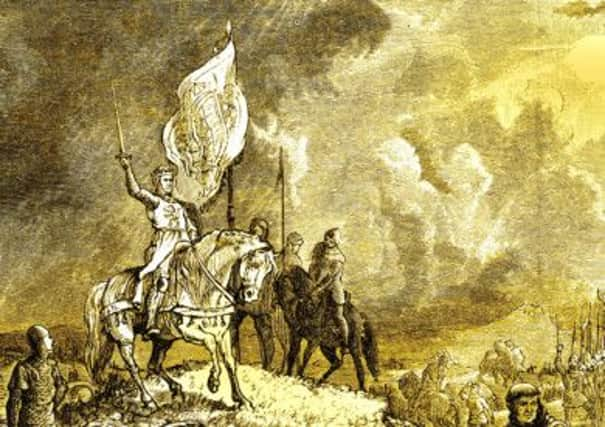Book review: Bannockburns by Robert Crawford


Bannockburns: Scottish Independence And Literary Imagination 1314-2014
Robert Crawford
Edinburgh University Press, £19.99
‘FROM the start,” the poet and critic Robert Crawford writes in this subtle and stimulating study, “Bannockburn was the most literary of battles.” It had its own poet in residence embedded in Edward II’s army, primed to hymn the English victors, and the surprise defeat of the English army by the ingenious Scots was destined to echo down the ages in the words of Robert Burns, Blind Harry and Jane Porter.
Advertisement
Hide AdPorter is the author of The Scottish Chiefs (1810), an epic novel of passionate philoscotticism which went through, Crawford tells us, at least 75 reprints in the 19th century. She is credited with creating a literary genre, “the national tale”. In her national tale Wallace is the hero, the pesky chronology is moved to make Bannockburn seem as if it occurred on the heels of Wallace’s execution, and the plot tends towards sensation and melodrama.
Porter is used as an example of the way Bannockburn resonated down the centuries and out to Scotland’s diaspora – a prism through which to view Scottish dependence and independence. Crawford discusses Bannockburn as a cornerstone of the national debate in Scotland, the site of multiple versioning and reversioning, and the historical event which looms behind Scotland’s 2014 independence referendum.
Many of the figures in this section are well known. But alongside RB Cunninghame Graham, Compton Mackenzie, Hugh MacDiarmid and Edwin Muir, Crawford marshals a powerful case for the significance of James Whyte, the young American editor who published MacDiarmid and who, Crawford contends, “presented in The Modern Scot the most nuanced theorisation of Scottish nationalism”. Whyte is woven into an ingenious attempt to connect his flexible, polyvocal model of Scottish identity to the political views of Alex Salmond via Salmond’s career as an undergraduate at St Andrews.
But Crawford’s argument glides over one apparent tension: on one hand he champions the “eccentric” views of the Nationalist writers of the 1930s who set their faces against the Unionist political and cultural orthodoxy of the time and ushered the Scottish National Party into being. Yet he also seems to approve of the fact that most of Scotland’s current writers have lined up on one side, and one side alone, of Scotland’s 21st century national argument. If artistic energy comes from eccentricity, from going against the grain, Crawford’s own argument implies that there is an artistic price to be paid for what seems to be a growing unanimity on the constitutional option facing the country.
In his introduction, Crawford writes “literature has shaped and sometimes been shaped by the resilient envisioning of Scottish independence”. And yet for all the modern Scottish poems, plays and novels which articulate a critique of Britishness, there are very few that “envisage” what an independent Scotland would be like, what it would feel like to live in it, and what kind of hard political choices it would have to make. One honourable exception is Andrew Crumey’s alternative history of Scotland, Sputnik Caledonia, which actually does come close to “envisioning” an alternative version of Scottish statehood. Crumey, who lives and works in Newcastle, will not have a vote in September 2014. There is also no mention of him in Crawford’s book.
Of course, there has never been a shortage of terrific political novels in Scotland, from Eric Linklater’s Magnus Merriman to James Robertson’s And The Land Lay Still. But Robertson’s novel, with its panorama of nearly 60 years of Scottish political history is not strictly an envisioning of independence, as much as a masterful synthesis of How We Got To Here, inspired, as Crawford explores, by Walter Scott.
Advertisement
Hide AdIf an opinion poll on the referendum were to discover that 90 per cent of Scotland’s dentists, or 75 per cent of its chemical engineers, intended to vote for independence, we would find the near unanimity of political opinion in one tiny sector of Scottish society extraordinary. But Scotland’s writers seem to have made their minds up, with those who disagree opting to keep quiet, or opt out of the debate rather than make a case against independence. CJ Sansom, who expressed his opposition to Alex Salmond and the SNP in an Afterword to his novel Dominion, gets a couple of mentions in Bannockburns, partly, one suspects, because it is hard to find any Scottish writer willing to say anything in public which is critical of independence.
Commenting on the 2012 collection of political essays Unstated: Writers On Scottish Independence, Crawford writes “[the book] gives the cumulative and probably accurate impression that if Scottish independence had been left up to creative writers, it would have been achieved long ago.” But that in itself begs a question. Are Scotland’s writers ahead of public opinion on independence or out of step with it? n